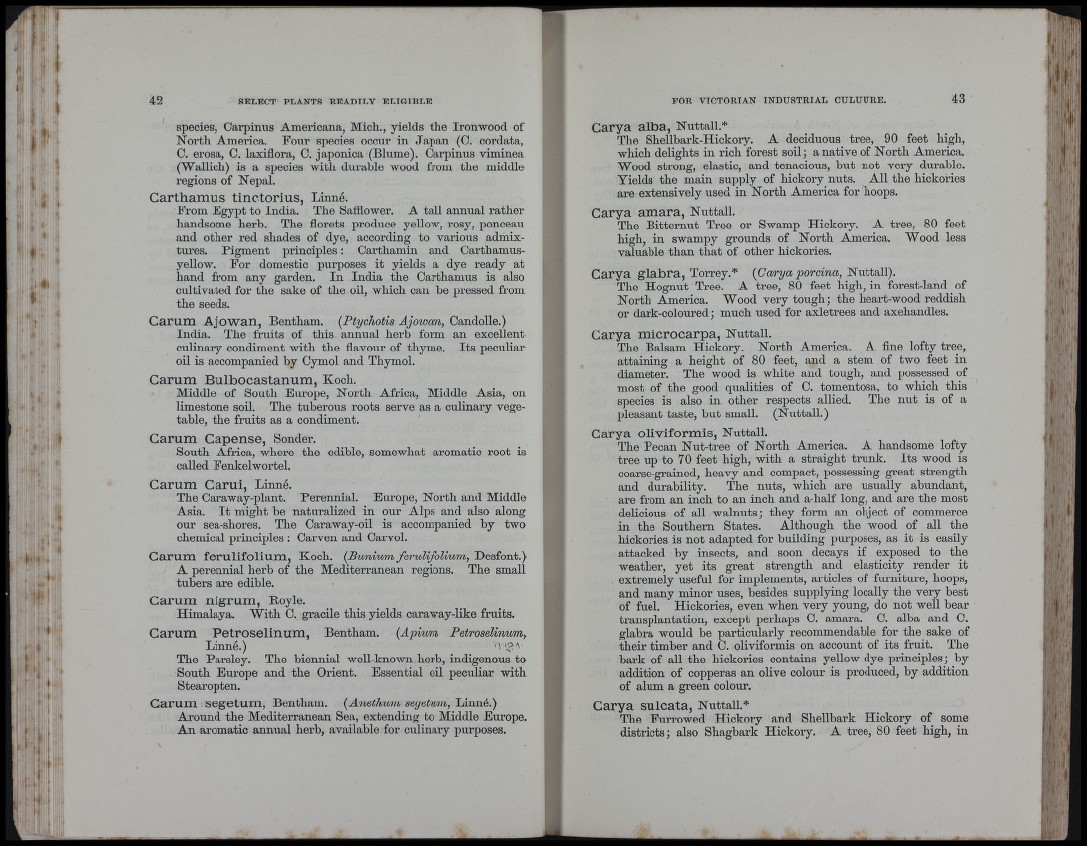
42
species, Carpinvis Americana, Mich., yields the Ironwood of
North America. Four species occur in Japan (C. cordata,
C. erosa, C. laxiflora, C. japónica (Blume). Carpinus viminea
(Wallich) is a species with durable wood from the middle
i-egions of Nepal.
Carthamus tinctorius, Linné.
From Egypt to India. The Safflower. A tall annual rather
handsome herb. The florets produce yellow, rosy, ponceau
and other red shades of dye, according to various admixtures.
Pigment principles : Carthamin and Carthamusyellow.
For domestic purposes it yields a dye ready at
hand from any garden. In India the Carthamus is also
cultivated for the sake of the oil, which can be pressed from
the seeds.
Carum Ajowan, Bentham. {Ptychotis Âjowan, Candolle.)
India. The fruits of this annual herb form an excellent
culinary condiment with the flavour of thyme. Its peculiar
oil is accompanied by Cymol and Thymol.
Carum Bulbocastanum, Koch.
Middle of South Europe, North Africa, Middle Asia, on
limestone soil. The tuberous roots serve as a culinary vegetable,
the fruits as a condiment.
Carum Capense, Sonder.
South Africa, whei’e the edible, somewhat aromatic root is
called Eenkelwortel.
Carum Carui, Linné.
The Caraway-plant. Perennial. Europe, North and Middle
Asia. I t might be naturalized in our Alps and also along
our sea-sbores. The Caraway-oil is accompanied by two
chemical principles : Carven and Carvol.
Carum ferulifolium, Koch. [Bunium ferulifolium, Desfont.)
A perennial herb of the Mediterranean regions. The small
tubers are edible.
Carum nigrum, Boyle.
Himalaya. With C. gracile this yields caraway-like fruits.
Carum Petroselinum, Bentham. {Apium Petroselinum,.
Linné.)
The Parsley. The biennial well-known herb, indigenous to
South Europe and the Orient. Essential oil peculiar with
Stearopten.
Carum segetum, Bentham. {Anethum segetum, Linné.)
Around the Mediterranean Sea, extending to Middle Europe.
An aromatic annual herb, available for culinary purposes.
Carya alba, Nuttall.*
The Shellbark-Hickory. A deciduous tree, 90 feet high,
which delights in rich forest soil; a native of North America.
Wood strong, elastic, and tenacious, but not very durable.
Yields the main supply of hickory nuts. All the hickories
are extensively used in North America for hoops.
Carya amara, Nuttall.
The Bitternut Tree or Swamp Hickory. A tree, 80 feet
high, in swampy grounds of North America. Wood less
valuable than th a t of other hickories.
Carya glabra, Torrey.* {Carya porcina, Nuttall).
The Hognut Tree. A tree, 80 feet high, in forest-land of
North America. Wood very tough; the heart-wood reddish
or dark-colonred; much used for axletrees and axehandles.
Carya microcarpa, Nuttall.
The Balsam Hickory. North America. A fine lofty tree,
attaining a height of 80 feet, and a stem of two feet in
diameter. The wood is white and tough, and possessed of
most of the good qualities of C. tomentosa, to which this
species is also in other respects allied. The nut is of a
pleasant taste, but small. (Nuttall.)
Carya oliviformis, Nuttall.
The Pecan Nut-tree of North America. A handsome lofty
tree up to 70 feet high, with a straight trunk. Its wood is
coarse-grained, heavy and compact, possessing great strength
and durability. The nuts, which are usually abundant,
are from an inch to an inch and a-half long, and are the most
delicious of all walnuts; they form an object of commerce
in the Southern States. Although the wood of all the
hickories is not adapted for building purposes, as it is easily
attacked by insects, and soon decays if exposed to the
weather, yet its great strength and elasticity render it
extremely useful for implements, articles of furniture, hoops,
and many minor uses, besides supplying locally the very best
of fuel. Hickories, even when very young, do not well bear
transplantation, except perhaps C. amara. C. alha and C.
glabra would be particularly recommendable for the sake of
their timber and C. oliviformis on account of its fruit. The
bark of all the hickories contains yellow dye principles; by
addition of copperas an olive colour is produced, by addition
of alum a green colour.
Carya sulcata, Nuttall.*
The Furrowed Hickory and Shellbark Hickory of some
districts; also Shagbark Hickory. A tree, 80 feet high, in
!l, (■
i I'